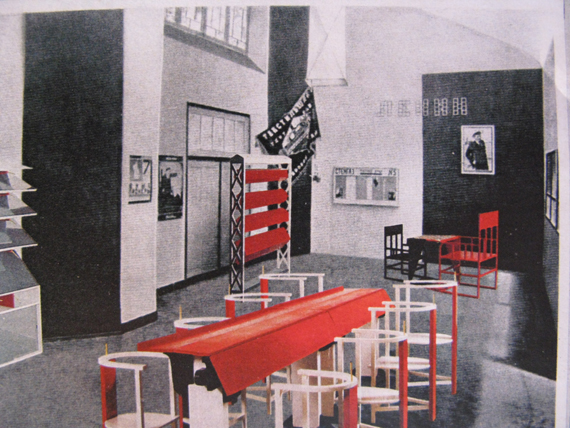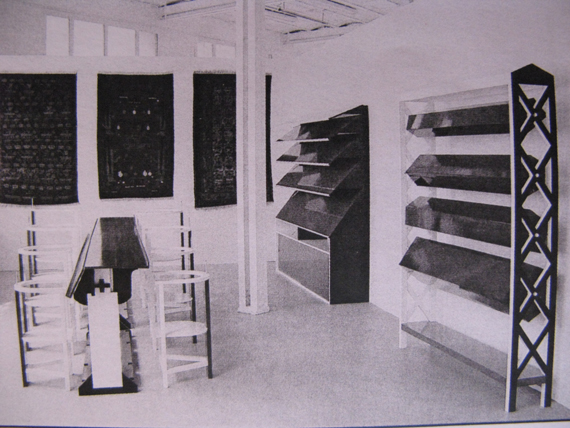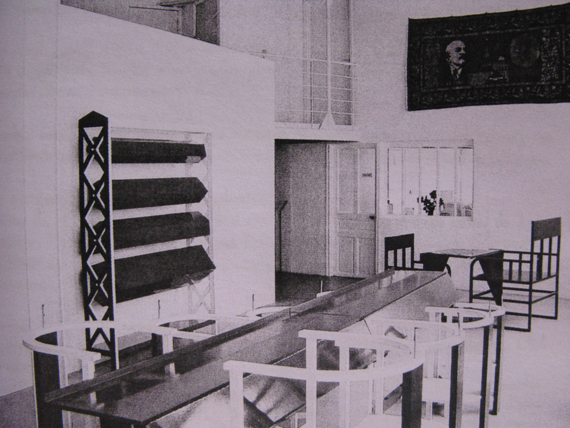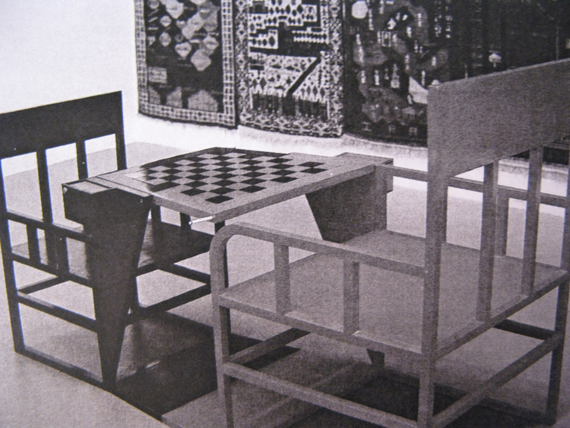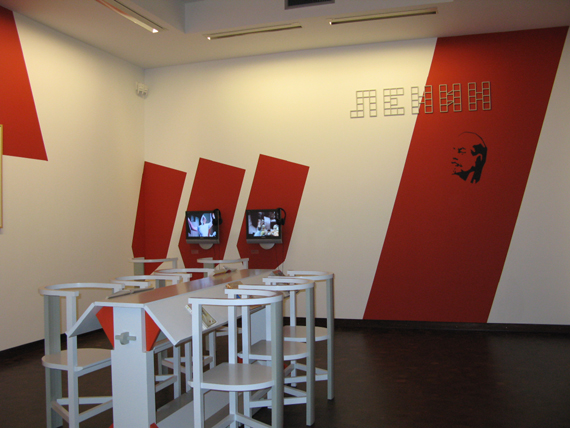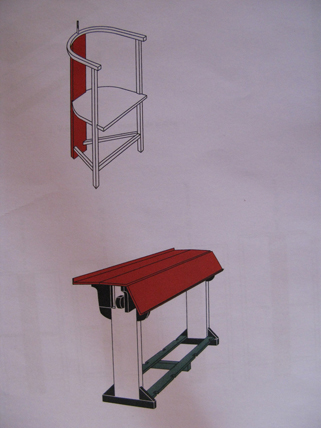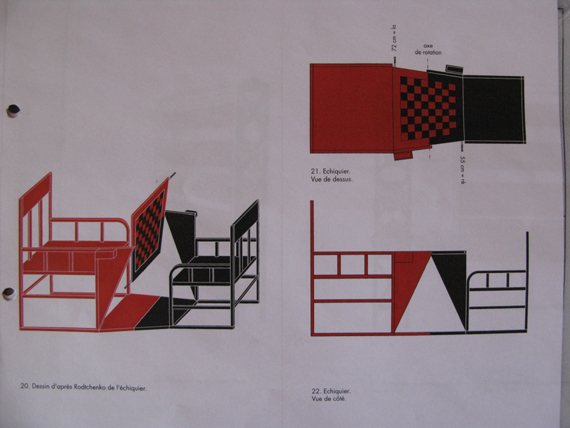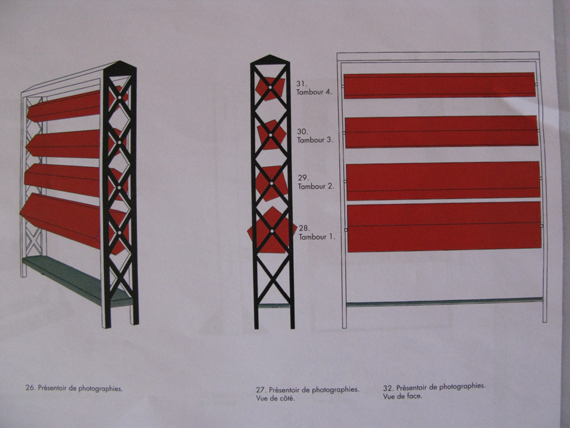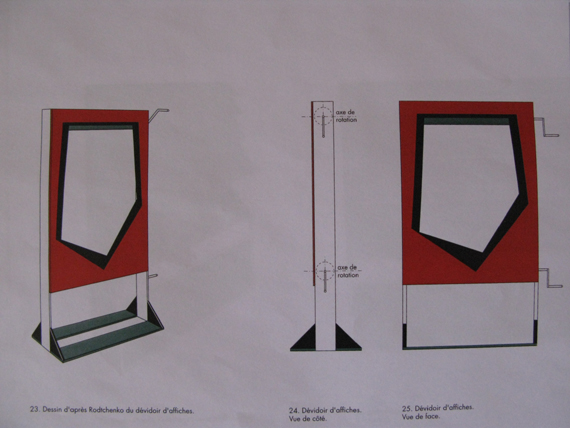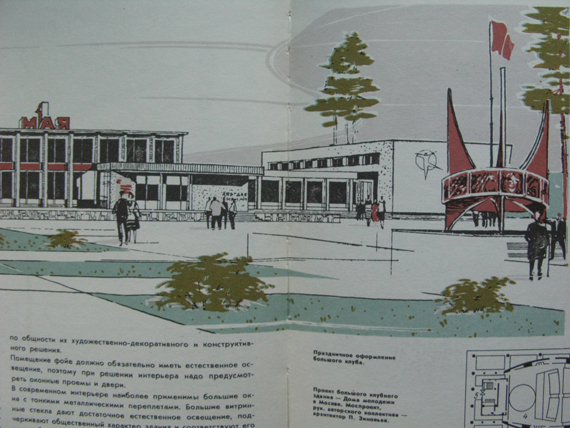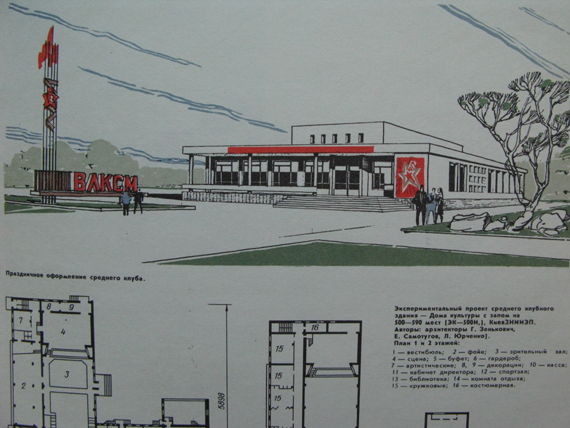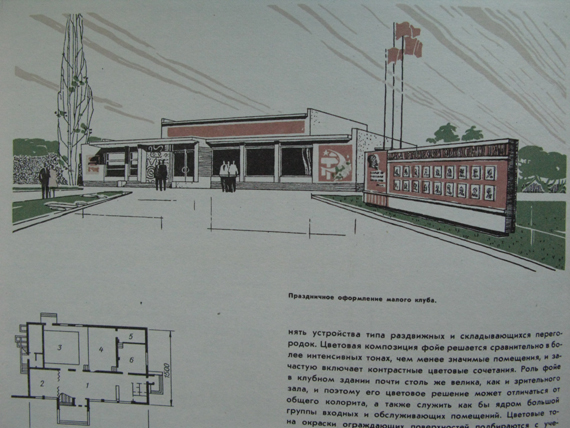03 2009
Activist Club or On the Concept of Cultural Houses, Social Centers & Museums
The topic of my talk today will be the use of art and the search for the forms and places where it could attain its emancipatory role in society. At the same time, I would like to call your attention to our recent collective project that we call “Activist Club”. Its genealogy is obviously rooted in the process of the development of so-called Workers Cultural Houses in the Soviet Union, and I would like to take this recent work as a kind of case study that will hopefully help us to tackle different aspects of the issues of this seminar. I would also like to point out that the topic of my talk is based on the results of editorial work that I did recently for the new issue of our newspaper Chto Delat with the title “What’s the Use of Art?” [1]
So I would like to start with a kind of “crude question”, which often asks art or critical reflection a simple thing: “What is the use of what you do?”
This question can, of course, provoke a quite negative reaction: it might be regarded as completely out of bounds, naive or just meaningless. If we take a closer look, however, we’ll find that it is both legitimate and essential.
It is clear that when we analyze it, we arrive at the old problem of the difference between the exchange and the use values of everything produced by human activity. Today, we can hardly take seriously the idea that art’s importance has to do with its anti-functionality, with its attempts to escape instrumentalization on the part of the culture industry or direct political action. The idea that art should dissolve into life, that it should be totally abolished in favor of daily life’s most basic functions, can likewise hardly be taken seriously today.
How can we find a way today to continue not only the project of Bildung —the process of individual development via aesthetic education (despite all the obvious sympathy for it) —but also find a new continuation for the project of art and thought as tools of a radical transformation of people’s consciousness?
From Schiller’s time on, the goal of art as aesthetic education was the harmonious development of the individual, the formation of a whole man capable of creativity. This concept, however, was oriented toward the individual bourgeois subject: in the final analysis, it leads to the formation of the egoistic individual. It is clear that a return to this concept today would be reactionary, which is exactly what the last Documenta unfortunately proved.
At the same time, I think that there is a general consensus about the statement that today’s decisive battle is shaping up around the production of subjectivity. This statement brings us back to an important starting point for this conference—the analysis of Soviet Productionism, which in the starkest form posed the question of a program of “life-construction.” As Boris Arvatov declared in his book Art and Production, “Art as an immediate and deliberately employed instrument of life-construction: such is the formula for the existence of proletarian art.”
Can we share these sentiments today? And where can we find a way to continue the project of proletarian art today? On the one hand, we are living during the prolonged transition to post-Fordism and knowledge capitalism. The farewell to the production line frees our hands—but where is that factory the Productionists dreamed of today? What once upon a time was a source of hope for progress and emancipation turned out, historically, to be a reactionary phenomenon that had to be overcome. The formation of “new political subjects,” whose analysis Italian operaismo undertook in the sixties, is the complete opposite of what the Productionists hoped for. The natural exodus of workers from the factory began, and along with it the “assembly line/collectivist” model of subject formation and the forms of its political organization also began to collapse.
Where can we find that factory today, or those means of production, whose seizure would supply us with an emancipatory impulse as precise as possible? Today this factory is nowhere and everywhere. The development of capitalism allows us to see the production of false subjectivity in the totality of capitalistic practices, which are now realized everywhere: in the thick of daily life, in institutions of culture, in the very networks of social interaction. It is this understanding that opens up new zones of struggle, not simply for non-alienated labor and knowledge, but also for the break with labor and production.
In this new situation, although I have a clear sense that many activists might not agree with, I think that we need another kind of knowledge and art, as never before. We need it as we need clean air: we need it to produce “oxygen” in an atmosphere totally polluted by the byproducts of the “creative industries.” But what should this knowledge/art look like? Where is the place where it can be useful and meaningful?
But let’s look at the current situation with the development of art practices that merge aesthetics, art and activism.
Over the last few years, a number of artists and writers have succeeded in both realizing and finding the theoretical grounding for a variety of works, which allows us to speak of a new situation in art. These projects have found points of connection between art, new technologies, and the global movement against neo-liberal capitalism. The lineages of this new interest in political art can be traced back to Documenta 10 (1997) and coincide with the emergence of the “movement of movements”, which erupted onto the political horizon in Seattle in 1999. This situation has subsequently been manifested through a variety of cultural projects, whose critical stance towards the process of capitalist globalization and emphasis on the principles of self-organization, self-publishing and a political understanding of autonomy – as the realization of political tasks outside the parliamentary system of power – all these factors have evoked the idea of a return to “the political” in art.
But to conceive of these artistic processes simply as “political” would be to seriously underestimate the situation we find ourselves in. There is evidence that what we are actually talking about can be interpreted as the emergence of an artistic movement: its participants are concerned with developing a common terminology based on the political understanding of aesthetics and autonomy; their praxis is based on confrontational approaches towards the cultural industry. This finds consistent realization in the international framework of projects carried out in networks of self-organized collectives working in direct interaction with activists groups, progressive institutions, different publications, online resources and so on.
From history we know that such traits were once one of the characteristics of the avant-garde. However, many people today see the avant-garde as something discredited by the Soviet experience, where the “dictatorship of the proletariat” rapidly degenerated into a “dictatorship over the proletariat” – a totalitarian situation that most activists and artists explicitly reject. But despite the anti-vanguardist principles of the “movement of movements”, I believe that some of the essential features of the avant-garde are crucial for understanding contemporary art.
As Jacques Rancière once mentioned (and I fully agree with him): “If the concept of the avant-garde has any meaning in the aesthetic regime of the arts, it is […] not on the side of the advanced detachments of artistic innovation, but on the side of the invention of sensible forms and material structures of life to come.”
But at the same time, today there is an enormous problem for any kind of revolutionary thought and aesthetics, which has limited opportunities to verify these “forms and material structures of life to come” in practice.
It is vital to find the opportunity to “stand one’s ground” despite everything—this is that rare “courage”, according to Badiou. But at the same time we have to try to avoid the collapse into madness and total marginalization that we often see happening within revolutionary leftist sects.
Our collective has its own position – taking over the existing means of production today is not such an efficient strategy. I think it is better to establish your own means of production and demonstrate how differently they can operate and enter into political negotiations with the system. So we need to institute our own structure, and Chto Delat sees itself as a new type of institution based on the principle of crystallization. What’s that? It means that we are not trying to dissolve our works in life, but do something just opposite to it – we are trying to crystallize some art practices in a variety of different situations – inside and outside the framework of cultural institutions.
We also find ourself closer to these issues, because in Russia we had to withdraw from the beginning from art territory and remain active in the other fields, mostly realizing and representing our works in a framework of different activists groups, civil society NGO, social forums, university and the Internet
We should keep in mind the whole problem complex of these very complicated questions, also because these questions are the backdrop for our approach to the realization of the project Activist Club.
The project started few years ago from my workshop with young Italian art students and activists – organized in the framework of the project “Common House”, curated by Marco Skotini at Teseco Art Foundation in Pisa.
The idea for this project obviously originated from the concept of the Workers’ Club introduced in the USSR in the mid-1920s and well known through the famous piece made by Alexander Rodchenko. Created in 1925 for the International Exhibition of Modern Decorative and Industrial Arts in Paris, it was never produced in real life. It was thus a kind of model of how such places should be organized. The piece introduced a western bourgeois audience to the completely different method of staging cultural activities in workers’ free time in the USSR (such as “Lenin’s Corner,” a space for gatherings and seminars, or the performance of “Live Newspapers,” etc.)
Alexander Rodchenko, Workers' Club (1925)
The task of the Workers’ Club was to provide workers with orientation on issues of political struggle and to introduce them to a different type of aesthetic experience and practicing art in the form of seminars, lectures and workshops. It critically undermined the obsolete idea of an idle consumer, who could derive pleasure and “emancipate” himself from shabby everyday existence through the experience of the art object in the museum. It was about building a space based on educational methodology, creativity and participation.
There is a growing interest in this concept and even direct reconstructions of workers clubs. Of course there have been several recent attempts to reconstruct this piece. Christiane Post attempted something like this at the 6th Werkleitz Biennale; there was an installation by Susan Kelly, “What is to be done?”; and a reading room at the exhibition Forms of Protest, at Van Abbe Museum.
Alexander Rodchenko, Workers' Club, reconstruction (Van Abbe Museum, Eindhoven, NL)
When we were preparing our first approach to the concept of an activist club in Pisa in 2006, I came across a publication by bookstorming.com and Galerie Decimus Magnus Art Editeurs (http://www.michelaubry.fr/livres.html, http://www.michelaubry.fr/mobilier.html ), a meticulous documentation of the reconstruction of Rodchenko’s Workers’ Club done by the French artist Michel Aubry. It was very inspiring to see one of the most famous works of the Russian avant-garde in an amazingly detailed reconstruction. Also, it shed light on many details of the composition that were not visible in the historical photographic documentation of the project.
Alexander Rodchenko, Workers' Club, reconstruction by Michel Aubry
We are not interested in reconstruction, however, but rather in a process that I would call the “actualization” of the general idea of what the concept of the workers’ club is about – actualization in a Benjamin sense, as the process of reclaiming its missed chance today.
For historical materialists history develops through the chain of events – revolutions or moments of popular mobilizations. Each of them is the culmination of revolutionary struggle for emancipation. It is quite important to conclude that the formation of a new subjectivity is not only shaped in relation to the current political situation, but also finds its shape in relation to the past. Why go backwards? Because the possibility of “becoming” is located not only in the possibilities of the present, but is also rooted in the actualization of all lost opportunities in the past.
So we have decided to concentrate on working on the concept of an activist club. And we keep believing that it makes sense to try to realize it in the form of an art project.
Why should it be art? Why not to try to realize it in a so-called midst of the multitude? Somewhere in real social life… Why do we need to find a shelter inside the art world for doing these kinds of things again?
That’s an important question, and I think that we are concerned with the possibilities of testing the significance of art and whether the project can hold up under the pressure of an institutional framework. Then there is hope that it will be reclaimed back into real life…
Another aspect is a more pragmatic one. At the moment, whether in Russia or anywhere else, we can hardly realize these ideas outside the art world. And here again, we run into the old discussion about relations between the spontaneous creativity of the masses, who do not need architects or artists to stage their activity, and those professionals who pursue other visions, which are determined in many ways, not just by the utilitarian and populist logic of the moment, but also in relation to the history of the breaks in the conventions of art production and its development as a living and emancipatory laboratory of forms of life to come – experimenting with something that does not yet exist.
We especially like the provocative quotation from the young Marx “We do not say to the world: Cease your struggles, they are foolish; we will give you the true slogan of struggle. We merely show the world what it is really fighting for, and consciousness is something that it has to acquire, even if it does not want to.” (Letter to Arnold Ruge, September 1843.)
And we always have the possibility to say this. For me, this quotation is also another point of departure for any revolutionary ideas that are capable of actualizing the multiplicity of avant-garde traditions.
So to come back to the idea of the activist club, we are talking about a self-imposed challenge that is, to a certain extent, comparable with that once placed by the Soviet government on Rodchenko: namely, to show the bourgeois public another means of producing the space where art can come together with political learning and subjectivation.
But the difference here is crucial: it is the difference between a self-imposed task carried out with the support of a western institution of contemporary art and the real backing of the Soviet state, and we should think more about this difference…
Yet looking into the core of the tasks, we can see that they essentially remain more or less the same – the essence is about how the artist can claim the true value of art.
Another aspect of my inspiration was the current discussion on the concept and role of social centers. It is important to notice that there is a move from the side of progressive museums to reconsider their public role. This was one topic of discussion at the recent conference here at MACBA, “Molecular Museum. Towards a New Kind of Institutionality,” which tackled the relation between museums and social centers. I think that for all of us the concept of the social center, as a place where art might be able to reveal its pure use-value and ignore its exchange value, is very important.
The new social centers strive to engage a broad caste of oppressed people and give them a chance to encounter culture and combine it with fighting for their rights of recognition. The discussion about the future of social centers can be connected with the concept of the workers’ club developed in the Soviet Union, because they share an approach to the value of art and the ways in which people can participate in its production.
But let’s look more closely at the concept of the Workers’ Club and its late implementation in the everyday life of the Soviet Union in the form of workers’ cultural centers – or “Houses of Culture”. What was that?
There is unfortunately very little research on this topic – carried out during the Soviet era and later when the whole system had practically collapsed – but we should take into account the dimension of these developments. In 1988 there were over 137,000 club establishments in the Soviet Union. And I think that everyone of my generation had some live and positive experience of these places.
House of Culture (dom kultury) was an establishment for many various recreational activities and hobbies: sports, collecting, arts. The Palace of Culture was designed to have room for all kinds of them. A typical Palace contained one or several movie theaters, halls, concert hall(s), dance studios, various do-it-yourself hobby groups, amateur radio, public library. All of these groups were free of charge until the most recent times. These houses usually were built and run by the trade union organization of one factory, but they were often established by local authorities – the local Soviet – and served the general public. They especially focused on children’s after-school education.
So it was a structure that embraced all kinds of so-called harmonious developments of a person. Rodchenko’s room was a quite modest proposal for designing just one module-space, but a few years after his Workers’ Club, it became the biggest challenge for many famous architects to construct whole huge buildings that could serve all these purposes.
Projects of cultural houses in the USSR
It is clear that the concept of social centers is rather close to the idea of People’s Cultural Houses, and I think that these experiences should be more closely studied.
But let’s go back to our project – Why activist?
I think that right now, at a time with very limited opportunities for the development of a culture of the oppressed, we should rethink the old question posed by Paulo Freire: “[I]f the implementation of a liberating education requires political power and the oppressed have none, how then is it possible to carry out the pedagogy of the oppressed prior to the revolution? This is a question of the greatest importance; one aspect of the reply is to be found in the distinction between systematic education, which can only be changed by political power, and educational projects, which should be carried out with the oppressed in the process of organizing them.”
Why this quotation? The grammar of this quotation quite precisely poses the question about processes of organization. “Them”: this is obviously all those people who, by virtue of their class status, acutely experience the injustice of the world, but who at the same time do not possess sufficient knowledge to be aware of the strategic tasks of their own emancipation.
In other words, according to the old, universally accepted model, there are certain privileged external agents who develop these practices of emancipation – that’s why discussions about the figure of the educator played such an important role in the Soviet Union and Latin America. In previous times, these were people connected to God and the Church; they were followed by revolutionary parties and psychoanalysts. After the obvious downfall of these mediators, the question remains: is education possible without a teacher? Today it is the figure of the teacher/pedagogue—as the figure of repression under the sign of education—who is rightly and seriously under suspicion.
But it might make sense to dialectically reconsider this figure as someone who stays in the process of an exchange of knowledge – someone who knows something, but is ready to be in a process of learning all the time and return this knowledge transformed.
So back to our topic today – I would say that the idea of a workers’ club is useless today on the level of the formation of subjectivity. For me, the shift from worker to activist is important. Historically, the worker’s identity had a marked political position, but I doubt that it does now. Today, political subjectivity is shaped inside and outside labor relations, and the position of the political subject is determined more through one’s stance as an activist.
A research paper was published recently in Russia by Carine Clément, the French sociologist who heads the Institute for Collective Action in Moscow. She presented the findings of her research on the new social movements in Russia. It was interesting that in her analysis of the processes by which the new movements are formed, she used a schema whose poles were two stances: that of the “philistine” (the passive, apolitical citizen) on the one hand, and that of the activist on the other. This, in essence, is a particular variation on the subjectivity formation schema. Clément cited the testimony of her activist-respondents, who described their experience of moving towards activist stances. They talked about how they had begun to see their lives from a new perspective, as being connected to the social whole. They said that they had gained a sense of self-worth, confidence, strength, and collective solidarity, the readiness to defend their positions. The transformation of the subject causes the person to see the world from the universal perspective of the whole and gives them a sense of personal strength and fearlessness.
So for us was important to address these people first of all – but we do not want to separate them as clean examples of right behavior from the wrong one, but instead to try to demand that everyone can be an activist and to assert that these experiences are open to anyone. Inspiring experiences have also emerged recently in different social centers in Europe, where activists are building their own environments for self-educational activities, centered around cinema and reading and discussion spaces.
But I am often disappointed by the quite trashy imagination of the spatial production that is normally realized in such centers, squats, and protest camps. I personally feel good inside them and of course prefer them much more than the over-hyped lounges that are so much adored by the new “creative class”, which are so disgusting in their cozy hedonism.
I think that such spaces should be organized differently. As our friends from Universidad Nomada once postulated:
For quite a while now, a certain portmanteau word has been circulating in the Universidad Nomada’s discussions, in an attempt to sum up what we believe should be one of the results of the critical work carried out by the social movements and other post-socialist political actors. We talk about creating new mental prototypes for political action. (http://transform.eipcp.net/transversal/0508/universidadnomada/en)
I would suggest that the same approach should be developed in relation to spatial practices. In this particular installation of the Activist Club, which was realized for an art institution, we were trying to demonstrate how these “spatial prototypes” could be realized and what they might look like. I hope that is one of the possible ways in which art can be developed today.
The institutional framework for my constructions serves as contextualization modules that provide viewers with an opportunity to experience the artwork produced by our collective in a proper setting. These are spaces where we screen our film and video works, distribute newspapers and other printed materials, where it is possible to accommodate seminar activities and discussions or run sociological research involving the public. These are spaces for contact with the public and their feedback, and the structure of the spaces is organized to serve these needs. Also, I would call them “take-away spaces”—we welcome any collective in need of a place for gathering and screening something.
The participatory moment is very important. So what we are building are the spaces where the viewer can encounter the work of art in a proper and (as we understand it) educational setting. I do not think that this necessitates a universal “concept”, but we should try to develop a method, an approach to the production of the space that can have a universal dimension. And I think that these claims for universality are sometimes misunderstood as something totalizing or exclusive of any difference. But you do not have to be a philosopher to recognize that this is not the case. True universality is built upon singular, local, and differentiated experiences, exactly as Marx noted in The Communist Manifesto: “From the numerous national and local literatures, there arises a world literature.”
---
[1] http://www.chtodelat.org/index.php?option=com_content&view=category&layout=blog&id=204&Itemid=295&lang=en


